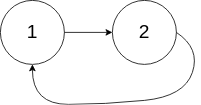Leecode 0142. Linked List Cycle II
142. Linked List Cycle II
Given the head of a linked list, return the node where the cycle begins. If there is no cycle, return null.
There is a cycle in a linked list if there is some node in the list that can be reached again by continuously following the next pointer. Internally, pos is used to denote the index of the node that tail's next pointer is connected to (0-indexed). It is -1 if there is no cycle. Note that pos is not passed as a parameter.
Do not modify the linked list.
Example 1:

1 | Input: head = [3,2,0,-4], pos = 1 |
Example 2:

1 | Input: head = [1,2], pos = 0 |
Example 3:

1 | Input: head = [1], pos = -1 |
题目大意
给定一个链表的头节点,判断链表中是否存在环。如果存在环,返回环的起始节点;如果不存在环,返回 null。
解题思路
采用快慢指针法(Floyd 算法) 来解决这个问题,该方法可以在 O (1) 的额外空间和 O (n) 的时间内找到环的起始节点:
- 检测环的存在:
- 使用两个指针,快指针(fast)每次移动两步,慢指针(slow)每次移动一步
- 如果链表中存在环,两个指针最终会在环中相遇
- 如果快指针到达 null,则链表中不存在环
- 找到环的起始节点:
- 当两个指针相遇时,将慢指针(或快指针)重置到链表头部
- 然后让两个指针以相同的速度(每次一步)移动
- 它们再次相遇的节点就是环的起始节点
1 | /** |
All articles on this blog are licensed under CC BY-NC-SA 4.0 unless otherwise stated.

